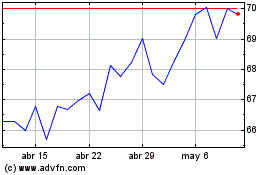Rio Tinto to develop BioIron™ R&D facility in Western Australia to test low-carbon steelmaking
03 Junio 2024 - 7:30PM
Business Wire
Rio Tinto will invest US$143 million (A$215 million) to develop
a research and development facility in Western Australia to further
assess the effectiveness of its low-carbon ironmaking process,
BioIronTM, to support decarbonising the global steel value
chain.
The development of the BioIron Research and Development Facility
in the Rockingham Strategic Industrial Area, south of Perth,
follows successful trials of the innovative ironmaking process in a
small-scale pilot plant in Germany.
BioIron uses raw biomass and microwave energy instead of coal to
convert Pilbara iron ore to metallic iron in the steelmaking
process. When combined with the use of renewable energy and
carbon-circulation by fast-growing biomass, BioIron has the
potential to reduce carbon emissions by up to 95% compared with the
current blast furnace method.
The BioIron facility will include a pilot plant that will be ten
times bigger than its predecessor in Germany. It will also be the
first time the innovative steelmaking process has been tested at a
semi-industrial scale, capable of producing one tonne of direct
reduced iron per hour. It will provide the required data to assess
further scaling of the technology to a larger demonstration
plant.
The plant has been designed in collaboration with University of
Nottingham, Metso Corporation and Western Australian engineering
company Sedgman Onyx. Fabrication of the equipment will begin this
year, with commissioning expected in 2026. These works are expected
to support up to 60 construction jobs.
The research and development facility will employ around 30
full-time employees and include space for equipment testing to
support further scaling up of the BioIron technology, while
developing a workforce highly skilled in steel decarbonisation and
supporting WA universities and research organisations.
Rio Tinto Iron Ore Chief Executive Simon Trott said, “The world
needs low-carbon steel to reach net zero, and we are working to
make this a reality by finding better ways to turn our Pilbara ores
into steel.
“BioIron is a world-first technology that has the potential to
play a significant role in a low-carbon steel future.
“This research and development facility will further test the
BioIron process, showcase Western Australian innovation capability,
and further demonstrates Rio Tinto’s commitment to supporting and
enabling the decarbonisation of the steel industry.”
Western Australian Premier Roger Cook said, “As one of the
world’s largest iron ore producers, it just makes sense for WA to
lead the world when it comes to low-emission steelmaking.
“Our plan to turn WA into a renewable energy powerhouse opens up
massive economic opportunities for the future, like producing
low-emission steel right here at home.
“Processing iron ore in WA will create jobs, reduce the world’s
carbon emissions and help to diversify and strengthen our economy
for decades to come.
“This is another job-creating clean energy project in our
industrial heartland of Kwinana and Rockingham, part of our
commitment to transitioning the industrial strip to a clean energy
future.”
Note to the editors
Fly through and B-Roll vision of the Western Australian BioIron
Research and Development Facility is available to download
here.
Steelmaking accounts for 8% of the world’s carbon emissions, and
69% of Rio Tinto’s Scope 3 emissions in 2023.
BioIron was invented by Rio Tinto’s steel decarbonisation team
after a decade of extensive research.
Electricity consumption in the BioIron process is about
one-third of the electricity required by other steelmaking
processes that rely on renewable hydrogen.
BioIron uses raw biomass such as agricultural by-products like
wheat straw, barley straw, sugarcane bagasse, rice stalks, and
canola straw, instead of coal as the reducing agent.
Rio Tinto is aware of the complexities around the use of biomass
supply and is working to ensure only sustainable sources of biomass
are used. Through discussions with environmental groups, as a first
step Rio Tinto has ruled out sources that support the logging of
old growth and High Conservation Value forests.
For more information about the BioIron process, please see
here.
Category: General
View source
version on businesswire.com: https://www.businesswire.com/news/home/20240603264140/en/
Please direct all enquiries
to media.enquiries@riotinto.com Media Relations,
United Kingdom Matthew Klar M +44 7796
630 637 David Outhwaite M +44 7787 597 493
Media Relations, Australia Matt Chambers
M +61 433 525 739 Jesse Riseborough
M +61 436 653 412 Alyesha Anderson
M +61 434 868 118 Michelle Lee M +61
458 609 322 Media Relations, Americas Simon
Letendre M +1 514 796 4973 Malika Cherry
M +1 418 592 7293 Vanessa Damha M +1
514 715 2152 Investor Relations, United Kingdom
David Ovington M +44 7920 010 978 Laura
Brooks M +44 7826 942 797 Wei Wei
Hu M +44 7825 907 230 Investor
Relations, Australia Tom Gallop M +61
439 353 948 Amar Jambaa M +61 472 865 948 Rio
Tinto plc 6 St James’s Square London SW1Y 4AD United Kingdom
T +44 20 7781 2000 Registered in England No. 719885
Rio Tinto Limited Level 43, 120 Collins Street Melbourne
3000 Australia T +61 3 9283 3333 Registered in
Australia ABN 96 004 458 404 riotinto.com
Rio Tinto (NYSE:RIO)
Gráfica de Acción Histórica
De Dic 2024 a Ene 2025

Rio Tinto (NYSE:RIO)
Gráfica de Acción Histórica
De Ene 2024 a Ene 2025
